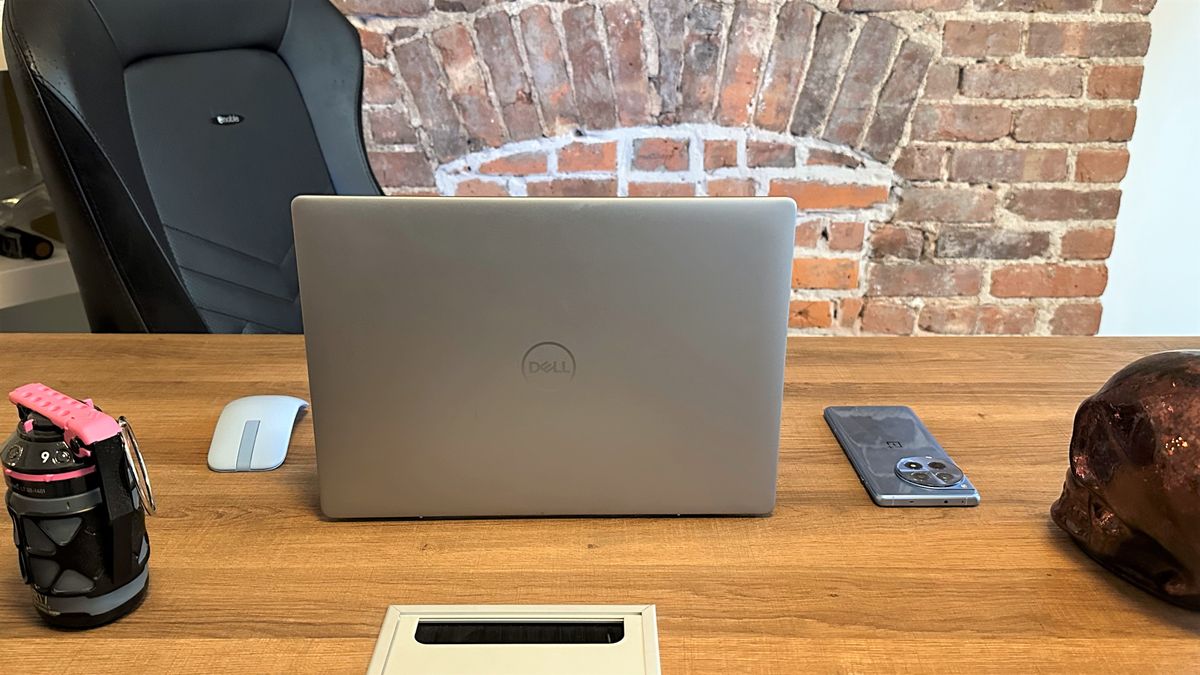
Okay, would it kill Asus to go a week without introducing another Zenbook 14 OLED laptop? We’ve reviewed five in nine months, with the models UX3404 and UX3405 now joined by the Zenbook 14 OLED Touch model UM3406. This one emphasizes AI with a new AMD Ryzen 8000 series CPU and a Microsoft Copilot key on the keyboard, and it’s a thrifty $849.99 at Walmart. That makes the Asus Zenbook 14 OLED Touch UM3406 the most tempting Zenbook yet for bargain hunters and an excellent alternative to the Intel-based Asus Zenbook 14X OLED (Q420), our short-lived Editors’ Choice award holder for midrange ultraportable laptops. Hey, at least it stayed in the family.Configurations and Design: A Change of Chips Officially known as model UM3406HA-WS74T, this new ultraportable snubs Intel for an eight-core AMD Ryzen 7 8840HS processor with base and boost speeds of 3.3GHz and 5.1GHz, respectively. Technically, this chip is the Ryzen 7 7840U seen in the HP Pavilion Plus 14 with the wattage and Ryzen AI NPU performance turned up a notch (16 versus 10 TOPS, the latest buzzword for trillion or tera operations per second in measuring AI speeds).
Since 1982, PCMag has tested and rated thousands of products to help you make better buying decisions. See how we test.
(Credit: Joseph Maldonado)
The laptop’s low price is explained by its OLED touch screen sticking to 1,920-by-1,200-pixel resolution and a 60Hz refresh rate. (However, Asus sells non-touch versions with the 2,880-by-1,800-pixel 120Hz panel we’ve seen before.) You also get a 512GB instead of 1TB solid-state drive and Windows 11 Home instead of Pro, though Asus doesn’t skimp with 16GB of memory. Like most AMD systems, this Zenbook lacks Thunderbolt 4 ports, but you’ll find two USB-C ports—one USB 3.2 and one 40Gbps USB4—on its right flank, along with an audio jack and HDMI monitor port. One USB 3.2 Type-A port is on the laptop’s left side. The power plug has a USB-C cable. Wi-Fi 6E and Bluetooth handle wireless connections.
(Credit: Joseph Maldonado)
(Credit: Joseph Maldonado)
Crafted from aluminum in a fingerprint-prone finish Asus calls Jade Black—which (a.) seems a contradiction and (b.) I keep typing as Jack Black—the Zenbook measures a svelte 0.59 by 12.3 by 8.7 inches and weighs 2.82 pounds. That makes it trimmer than the HP Pavilion Plus (0.74 by 12.4 by 8.9 inches, 3.04 pounds), though the status and price king of the 14-inch class, Lenovo’s ThinkPad X1 Carbon Gen 12, uses magnesium and carbon fiber to undercut it at 2.47 pounds. The system has passed MIL-STD 810H torture tests against road hazards like shock, vibration, and extreme temperatures. It shows no flex if you grasp its skinny screen bezels (with an 87% screen-to-body ratio) and just a little if you mash the keyboard deck. You’ll find no fingerprint reader here, but the webcam includes Windows Hello face recognition as well as a sliding privacy shutter.
(Credit: Joseph Maldonado)
Using the Asus Zenbook 14 OLED Touch: A Copilot Key, an Emoji Key, and Some Useful Keys Asus’ keyboard features three levels of backlighting, and its top row houses several shortcuts and controls: brightness, volume adjustments, microphone settings, an emoji pop-up panel, and a key to launch the MyAsus control center. This app combines system updates with settings such as noise cancellation, cooling modes, networking optimizations, and native, sRGB, and DCI-P3 color palette controls. Per Microsoft’s demand, a Copilot AI assistant key replaces the context-menu key to the right of the space bar, though you won’t find real Home, End, Page Up, or Page Down keys—those functions pair the Fn key and cursor arrows as on many compact laptops. The keyboard has a shallow but snappy and pleasant typing feel. The large buttonless touchpad glides and taps smoothly, though didn’t seem to have an LED numeric keypad mode as some Zenbooks do and the UM3406 web page promises—I found no icon or hotspot at the top right to activate the feature.
(Credit: Joseph Maldonado)
The 1080p webcam supports Windows’ recently added auto-framing and background-blur features using the processor’s AI hardware. The camera captures reasonably well-lit and sharp images with decent color and minimal noise or static. Bottom-mounted speakers produce clean and clear sound, though it’s not that loud and you’ll hear no detectable bass. However, voices and instrumentals are clearly heard from these speakers, as are overlapping tracks. Dolby Atmos software provides music, movie, game, and voice modes and an equalizer. We’ve seen several nifty 2,880-by-1,800-pixel OLED slimline screens, so this Zenbook’s 1,920-by-1,200 resolution is a minor disappointment, but it’s a first-rate OLED panel for the price. Its details and fine lines are sharp with no pixelation around the edges of letters, and though not super-duper-bright the display shows lavish, deeply saturated colors with ample contrast. The screen’s white backgrounds are pristine, which is helped by the ability to tilt the screen back as far as you like, and its viewing angles are broad.
(Credit: Joseph Maldonado)
Besides MyAsus, the Zenbook comes with a few other utilities, These include ScreenXpert for arranging and managing app windows, GlideX for extending the laptop display onto and swapping files with a smartphone or tablet, and a McAfee LiveSafe trial.Testing the Asus Zenbook 14 OLED Touch: Approaching Core i9 Territory We could have populated our benchmark charts entirely with Asus Zenbook 14 OLEDs, but decided to include only one—the Intel Core Ultra 7-powered model UX3405—alongside today’s topic, the $450-cheaper UM3406 Touch. The HP Pavilion Plus 14 has an AMD Ryzen 7000 series CPU nearly identical to the new Asus’ Ryzen 7 8840HS, while the $750-as-tested Dell Inspiron 14 2-in-1 convertible relies on a step-down Ryzen 5 7540U. Another Intel Core Ultra 7 ultraportable, the IPS-screened Acer Swift Go 14, rounds out our test group.
Productivity Tests We run the same general productivity benchmarks across both mobile and desktop systems. Our first test is UL’s PCMark 10, which simulates a variety of real-world productivity and office workflows to measure overall system performance and also includes a storage subtest for the primary drive. Three other benchmarks focus on the CPU, using all available cores and threads, to rate a PC’s suitability for processor-intensive workloads. Maxon’s Cinebench R23 uses that company’s Cinema 4D engine to render a complex scene, while Geekbench 5.5 Pro from Primate Labs simulates popular apps ranging from PDF rendering and speech recognition to machine learning. We also use the open-source video transcoder HandBrake 1.4 to convert a 12-minute video clip from 4K to 1080p resolution (lower times are better). Finally, we run PugetBench for Photoshop by workstation maker Puget Systems, which uses the Creative Cloud version 22 of Adobe’s famous image editor to rate a PC’s performance for content creation and multimedia applications. It’s an automated extension that executes a variety of general and GPU-accelerated Photoshop tasks ranging from opening, rotating, resizing, and saving an image to applying masks, gradient fills, and filters.
The Zenbook 14 OLED Touch led the way in PCMark 10 (scoring more than 4,000 points to indicate fine productivity in office apps) and most of our CPU tests. The laptop’s new Ryzen 7 processor matched the best Intel Core i7 chips we’ve seen outside of high-wattage gaming laptops. The Zenbook 14 OLED Touch has enough horsepower for not only routine office apps but also light-to-medium digital content creation. Graphics Tests We test Windows PC graphics with two DirectX 12 gaming simulations from UL’s 3DMark, Night Raid (more modest, suitable for laptops with integrated graphics) and Time Spy (more demanding, suitable for gaming rigs with discrete GPUs). Additionally, we run two tests from the cross-platform GPU benchmark GFXBench 5, which stresses both low-level routines like texturing and high-level, game-like image rendering. The 1440p Aztec Ruins and 1080p Car Chase tests, rendered offscreen to accommodate different display resolutions, exercise graphics and compute shaders using the OpenGL programming interface and hardware tessellation respectively. The more frames per second (fps), the better.
The UM3406 jockeyed with its UX3405 stablemate at the head of the pack, but we’re not saying it’s a fast pack—ultraportables’ integrated graphics simply aren’t in the same time zone as gaming laptops’ discrete GPUs. Stick to casual gaming and video streaming, not fast-twitch titles. Battery and Display Tests We test each laptop and tablet’s battery life by playing a locally stored 720p video file (the open-source Blender movie Tears of Steel) with display brightness at 50% and audio volume at 100%. We make sure the battery is fully charged before the test, with Wi-Fi and keyboard backlighting turned off.To gauge display performance, we also use a Datacolor SpyderX Elite monitor calibration sensor and its Windows software to measure a laptop screen’s color saturation—what percentage of the sRGB, Adobe RGB, and DCI-P3 color gamuts or palettes the display can show—and its 50% and peak brightness in nits (candelas per square meter).
The two Zenbooks crushed the competition in our battery rundown, with the OLED Touch lasting nearly 20 hours. Its screen’s color coverage was a match for its stamina, with rich, vivid hues and plenty of brightness (OLED technology’s sky-high contrast means we’re satisfied with a bit less than the 400-plus nits we prefer from IPS panels). These results support our positioning of the Zenbook OLED Touch as an entry-level content creation laptop.Verdict: Attention, Walmart Shoppers, to this Excellent Laptop DealOne of Asus’ countless other Zenbook 14 OLED models, the AMD Ryzen 7 7730U-based Asus Zenbook 14 OLED UM3402, earned a four-star recommendation in August 2023 and was recently ousted from our ultraportable roundup by none other than the Asus Zenbook 14X OLED (Q420). Joined by today’s UM3406 in the under-$900 club, the UM3402 has a sharper screen but we griped that its performance trailed that of Intel systems. (Hence the Q420’s recent position.) By contrast, the Ryzen 7 8840HS-packing Asus Zenbook 14 OLED Touch UM3406 can slug it out with Intel’s finest and lasted four hours longer on battery power—reason enough to bestow it with our Editors’ Choice award for frequent flyers in economy class.
Asus Zenbook 14 OLED Touch (UM3406)
The Bottom Line
The latest in Asus’ overflowing Zenbook 14 OLED family skimps a bit on the screen resolution but delivers impressive power, battery life, and convenience for $850.
Like What You’re Reading?
Sign up for Lab Report to get the latest reviews and top product advice delivered right to your inbox.
This newsletter may contain advertising, deals, or affiliate links. Subscribing to a newsletter indicates your consent to our Terms of Use and Privacy Policy. You may unsubscribe from the newsletters at any time.






